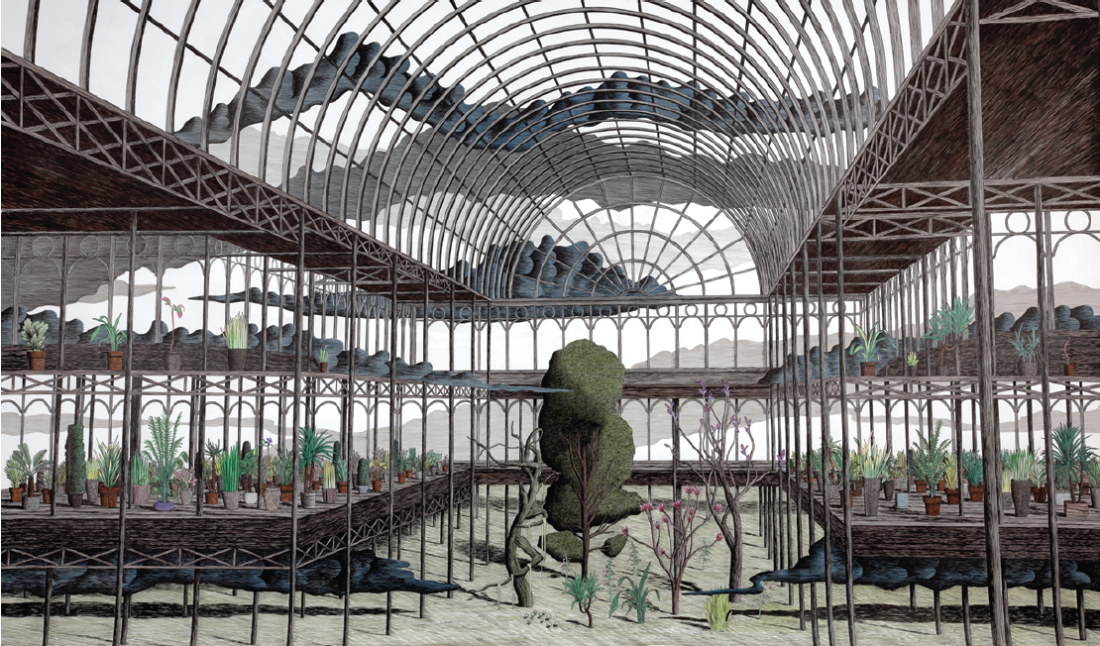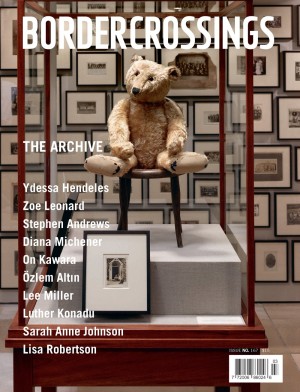Luke Painter
Luke Painter combines the traditional medium of drawing with digital tools used by contemporary architects to create haunting works that destabilize the viewer’s sense of space and time. The surreal and dream-like images led me to search the works for the foreboding and magical narratives I believe to be buried in the creeping fog and dark forests.
A mid-career artist, Painter blends his extensive knowledge of art, architecture and history to create complex compositions that are the result of a laborious and time-consuming process of mark- making. For the body of work in “Anterior,” Painter has used coloured and India ink to create drawings that have the textured appearance of traditional wood engravings. Perhaps it is his experience as a printmaker that inspired him to predominantly employ the muted tones of chromolithography, but he combines this palette with the selective use of bright colour highlights that heighten the sense of suspense in the haunting scenes.
Painter uses 3-D software to construct his intricate compositions, which he then draws directly from the image on the screen, including all the inconsistencies inherent in a flattened three-dimensional model. This serves to further confuse the viewer’s perspective, amplifying the surreal.
The curiously flattened Saarinen House, 2012, emphasizes this uncertainty. Painter depicts the Saarinen home in Michigan, which was designed in the early 20th century by Finnish architect Eliel Saarinen to include forms and ideas from both the Arts and Crafts Movement and Art Deco. The muted colours and leafless trees in this drawing create a sense of desolation. The compressed plane of the house gives it the presence of a fortress, and the dead trees seem to take on the role of sentinels. This forbidding defense is juxtaposed with the windowpanes that reflect a bright blue sky, causing it to seem as though it might actually be a bright sunny day. This is further complicated by Painter’s decision to leave the background empty. The stark white of the paper leaves the house suspended in a seemingly incomplete narrative.

Luke Painter, Crystal Palace Warehouse, 2012, coloured and India ink on archival paper, 48 x 72” framed. Photograph: Luke Painter. Courtesy the artist.
For Crystal Palace Warehouse, 2012, Painter has used a digital model of the glass and steel structure created in 1851 for the Great Exposition in London. He reproduced an interior view, but gives the iron elements the texture of wood, which would have been a structural impossibility. The Crystal Palace, which was named for the glass that was used on an unprecedented scale, has been altered, as there seems to be no barrier between the exterior and interior. Dark fog or clouds creep into the building and create an ominous quality. Painter incorporates mock-ups of potted plants and trees designed for architects to use in presentation renderings. The absence of people in Crystal Palace Warehouse adds to a sense of unrest. Although there are no people in the image, the potted plants create a human presence, but it is as though something has suddenly eradicated the people in favour of a darker force.
Several works include patterns based on the work of William Morris, a British textile designer, artist and writer who worked in the latter half of the 19th century. It is revealing to know that Morris’s literary works are among the first to create entire fantasy worlds and were an inspiration to JRR Tolkien. The complex interwoven designs composed of flora and fauna are incorporated into fantastical architectural structures that seem to be the result of Painter’s creative amalgamation of the varied facets of Morris’s artistic production.
A series of three works depicting disembodied hands holding precious architectural models (or could they be huge hands that have lifted the actual structures off their foundations?) is explicit in its Surrealism. While all of Painter’s works are inextricably connecting contemporary culture with historical elements, the collision of ornament from the past and present is blatant in this triptych. Painter’s fascination with present-day forms of decoration inspire him to depict elaborately manicured fingernails. He considers the increasingly detailed images and designs depicted on nails to be a form of artwork, although most people might not classify it as such. In Gothic Cathedral with Starry Night Nail Polish, 2012, Painter recontextualizes an elaborate manicure, suspending it in fantasy, fine art, the historical and perhaps even the spiritual ideas inherent in a cathedral. The tension moves beyond the clash of ornament as the viewer is left wondering whether the hand is offering up the edifice or is preparing to crush it (of course, hoping not to break a nail in the process).
Painter’s painstaking drawings build on a tradition of storytelling that forces the audience to imagine. His work engages the viewer in an act of play and creativity, as it seems impossible to look at his works without envisioning myriad stories in a beautifully grim land of unrealities. ❚
“Anterior” was exhibited at Le Gallery, Toronto, from May 2 to May 27, 2012.
Krystina Mierins is a Toronto-based independent writer.

